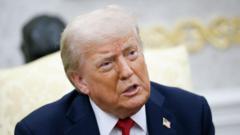Despite facing significant challenges from U.S. tariffs and a troubled real estate sector, China's economic growth has exceeded expectations, raising questions about the future economic landscape.
China's Economic Growth Surprises Despite Looming Tariffs

China's Economic Growth Surprises Despite Looming Tariffs
China's economy shows resilience with a 5.2% growth, defying tariff-related concerns from the U.S.
China's economy expanded by 5.2% in the second quarter compared to the previous year, outpacing the anticipated 5.1% and reflecting a degree of strength amid ongoing trade tensions with the United States. This growth comes despite heightened tariffs imposed by the Trump administration and a protracted crisis in the property market, which continues to impact consumer confidence and investment.
The Chinese National Bureau of Statistics reported that the manufacturing sector played a pivotal role in this growth, recording a 6.4% increase as demand for advanced technologies such as electric vehicles and industrial automation surged. However, the services sector, incorporating essential industries like finance and technology, also contributed positively.
Still, retail sales have faced a slowdown, registering a growth rate of just 4.8% in June, down from a more robust 6.4% the month prior. The property market, critical to economic stability, is showing alarming signs, with home prices decreasing at an unprecedented rate over eight months, as governmental measures appear to have minimal effect thus far.
Economists were bracing for a more profound decline due to the tariffs, but some now depict China as "highly resilient." Export stimulus was noted as firms expedited shipments before any potential tariff changes take effect. Experts project that the second half of the year may prove more uncertain, positioning the Chinese government to potentially amplify economic support measures to ensure targets are met.
While the government aims for an annual growth rate around 5%, some analysts caution that China may struggle to reach this target, estimating it may stabilize at a minimum of 4%, a politically acceptable threshold. This comes amidst a backdrop of escalating tariffs during the U.S.-China trade conflict, with a heavy 145% levy on Chinese imports, and retaliatory actions that have strained international trade relationships.
Negotiations between the U.S. and Chinese officials are ongoing, with a deadline of August 12 to forge a lasting agreement that could alleviate economic pressures on both sides. As stakes remain high, the global economic ramifications of these negotiations and tariffs will be closely monitored by analysts and governments worldwide.
The Chinese National Bureau of Statistics reported that the manufacturing sector played a pivotal role in this growth, recording a 6.4% increase as demand for advanced technologies such as electric vehicles and industrial automation surged. However, the services sector, incorporating essential industries like finance and technology, also contributed positively.
Still, retail sales have faced a slowdown, registering a growth rate of just 4.8% in June, down from a more robust 6.4% the month prior. The property market, critical to economic stability, is showing alarming signs, with home prices decreasing at an unprecedented rate over eight months, as governmental measures appear to have minimal effect thus far.
Economists were bracing for a more profound decline due to the tariffs, but some now depict China as "highly resilient." Export stimulus was noted as firms expedited shipments before any potential tariff changes take effect. Experts project that the second half of the year may prove more uncertain, positioning the Chinese government to potentially amplify economic support measures to ensure targets are met.
While the government aims for an annual growth rate around 5%, some analysts caution that China may struggle to reach this target, estimating it may stabilize at a minimum of 4%, a politically acceptable threshold. This comes amidst a backdrop of escalating tariffs during the U.S.-China trade conflict, with a heavy 145% levy on Chinese imports, and retaliatory actions that have strained international trade relationships.
Negotiations between the U.S. and Chinese officials are ongoing, with a deadline of August 12 to forge a lasting agreement that could alleviate economic pressures on both sides. As stakes remain high, the global economic ramifications of these negotiations and tariffs will be closely monitored by analysts and governments worldwide.





















